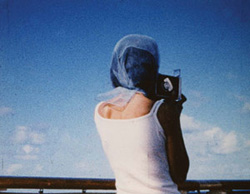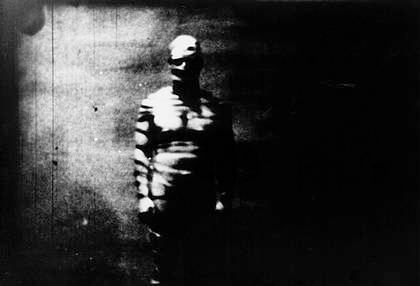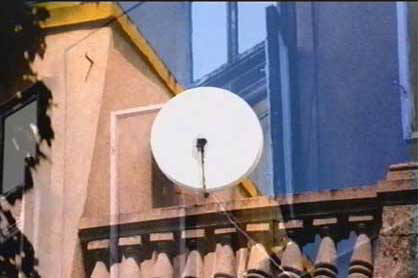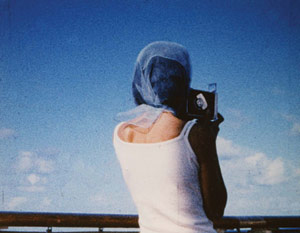Part of Fall 2001
Sabine Jelinek In Person
A co-presentation with Mercer Union
Organized by Viennese artist Sabine Jelinek, A Blink of an Eye is a rare opportunity to view a brief cross-section from the history of Austrian experimental film and video work from the 1960s to 2000. “After World War II, Austrian artists had their first opportunities to radically break from conventional uses of the medium, bringing an intuitive Viennese fascination for formal expression and control, and an urgent confrontation of elemental physical experience. Unmindful of, or perhaps welcoming, the void in which they were operating, they began a vital movement which continues to this day. The reasons for Austria’s immense contribution to the history of international avant-garde film are easily traced: while the social and cultural life of the post-war period was marked by a collective repression of National Socialism, the artistic avant-garde took up the heritage of the Viennese fin-de-siecle (Schoenberg, Webern, Wagner, Loos, Musil, Wittgenstein, Freud.) In the Vienna of the 1950s, the fine arts and literature evolved with extraordinary vigor, and the roots of their radicalism lie in their conflict with a society typified by authoritarian clerical attitudes. Film, the youngest of the arts, was the last to develop a polemical, avant-garde community in tradition-bound Vienna. By the mid 1950s America had seen films by Deren, Anger, Brakhage and others. France already had a long tradition of avant-garde film, at that time most notably in work created by Genet, Lemaitre, Isou and the Situationists. After World War II, Austrian artists had their first opportunities to radically break from conventional uses of the medium, and they brought to their efforts an intuitive Viennese fascination for formal expression and control, and an urgent confrontation of elemental physical experience. Unmindful of, or perhaps welcoming the void in which they were operating, they began a vital movement which continues to this day. A “second generation” of Austrian filmmakers depended less on control of plastic form, sometimes turning to a complete subversion of formal control (Schmidt Jr.) sometimes to more conceptual and theoretical underpinnings for their work (Export, Scheugl, Weibel). Here, too, though their art confronted the viewer sensually, often bringing issues of the body directly into question. These works struck the exposed nerves of their viewers; many of the filmmakers and artists during these decades were physically attacked, imprisoned or exiled. The last decade has seen a considerable fanning out of stylistic approaches, but the avant-garde film is robustly alive; most Austrian artists working with forms of actionism proudly think of themselves in this tradition, and the newer work still packs a punch for the senses and mind.” (Sabine Jelinek, August 2001)
A Blink of an Eye: Austrian Experimental Film and Video Art was organized by Viennese artist Sabine Jelinek in collaboration with SQUATSPACE, Sydney, and The Artists Village, Singapore.
Programme I:
16/67 20. , Kurt Kren (1967, 16mm, b/w, silent, 7:00 min.)
Kurt Kren made films from the material happenings and actions by Otto Muehl and Gunter Brus between 1964 and 1966. While Kren’s films remain some of the best documentary material from the Austrian Actionists, they are considered works of art in their own right. The London Film-Makers Cooperative called this film the “Eating, Drinking, Pissing, and Shitting film”. Kren says: This film had to be made. LFMC says: It had to be Kren who made it. (Neuer Oesterreichischer Film. Katalog, 1970).
Bodybuilding, Ernst Schmidt Jr. (1965/66, 16 mm, colour, 9:00 min.)
Otto Muehl’s performance Bodybuilding is out of a period where he conceives his actionist works almost exclusively for photographic and film documentation. (Hubert Klocker)
Passagen (Passages), Lisl Ponger (1996, 35mm/16mm, colour, 12:00 min.)
Using found amateur film material, Lisl Ponger creates an imaginary map of the 20th century on which people’s stories of involuntary emigration are engraved like well-worn tracks of occidental memory. (Christa Blümlinger)
Mariage Blanc (White Marriage), Gustav Deutsch (1996, 16mm, colour, 5:00 min.)
In his films, Gustav Deutsch has developed a humorous variant on structural filmmaking. His Mariage Blanc (White Marriage) follows a serial order, in which Mostafa Tabbou, a Moroccan man, announces his desire to marry a European woman. He works his way through each of the European nations, in a 14-part, 14-language video personal ad. (Mariage Blanc
in Morocco means a sham marriage in order to obtain citizenship of a European country.) The film, a humorous fictional reflection of the third world’s desire for emigration, is at the same time, for Tabbou, a very real proposition – at the end of Mariage Blanc he leaves us his address and phone number for replies.
How evil is austria?, Bernadette Huber (2000, video, colour, 2:00 min.)
A “scandalous film.” The text moves over the screen: quotations from Haider. In the background a vagina is giving birth to a distorted Austrian flag.
Vienna Boogie 2000, Sabine Jelinek (2000, super 8, colour, 4:00 min.)
Every Saturday since the formation of the new rightwing-conservative government in Austria, young people have danced and marched, accompanied by popular DJs, through the streets of Vienna. The protests against the government are still going on.
Programme II:
Alone. Life Wastes Andy Hardy, Martin Arnold (1998, 16mm, b/w, 15:00 min.)
Mickey Rooney and Judy Garland are cloned in an experimental “backyard musical.” Several movie musical fragments are put in a new order and before our eyes run forwards and backwards in a “gentle adagio.” (Martin Arnold)
Es hat mich sehr gefreut (I Have Been Very Pleased), Mara Mattuschka (1987, 16mm, b/w, 2:00 min.)
“and the old Emperor spoke: Thank you, its been very nice. I am very pleased!”
SOS Extraterrestria, Mara Mattuschka (1993, 16mm, b/w, 10:00 min.)
The world as a plaything for a giantess from outer space.
Parabol (Parabola), Flora Watzal (1999, Beta SP, colour, 6:00 min.)
The centrepieces of Parabol, literally at the exact centre of the image, are parabolic antennas, commonly termed satellite dishes. Watzal uses the dishes as a metaphor for the ocular “blind-spot,” as they are the often-unseen apparatus, which delivers images to every home.
rewind, [n:ja] & Shabotinski (2000, Beta SP, colour, 5:00 min.)
rewind by video artist [n:ja], began from a piece entitled Rueckenwind by the musician Shabotinski. The ultimate goal was to create a symbiotic relationship between the audio and visual material. Acoustic interferences are reproduced as visual impurities and break through the time axis in a rhythmic way predetermined by the music.
La Sortie, Siegfried A. Fruhauf (1998, 16mm, b/w, 6:00 min.)
“The initial image &lrquo;˜workers crossing in a factory corridor’ is transformed into almost abstract black and white surfaces and harnessed, Sisyphus-like, in a lunatic dance of repetition. (Peter Tscherkassky)
Sabine Jelinek was born in Vienna in 1969. She received an MFA with honours from the Academy of Fine Arts in Vienna, and a scholarship for artistic photography in New York City in 2001. She is a photographer, filmmaker and video artist, and has participated in various exhibitions worldwide as well as the Diagonale and Kassel film festivals in Austria and Germany respectively in 2000.



